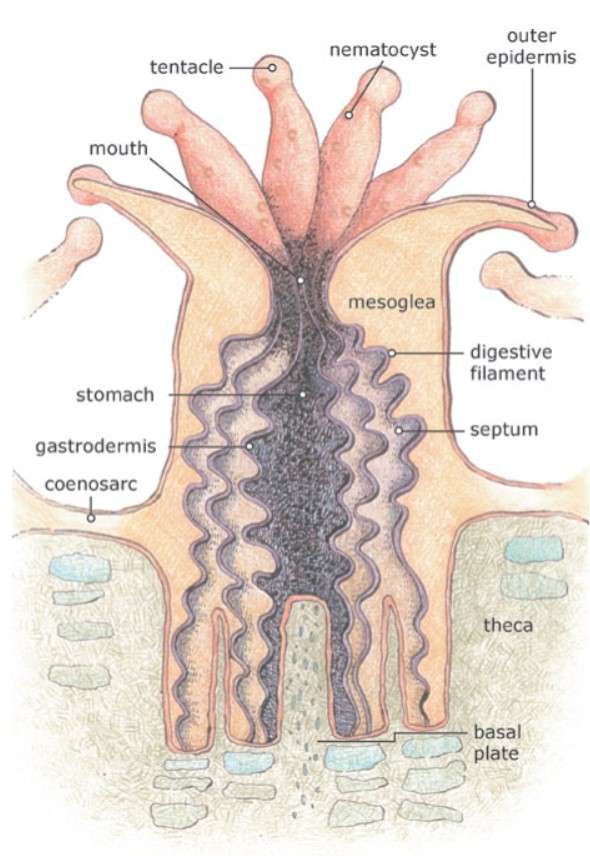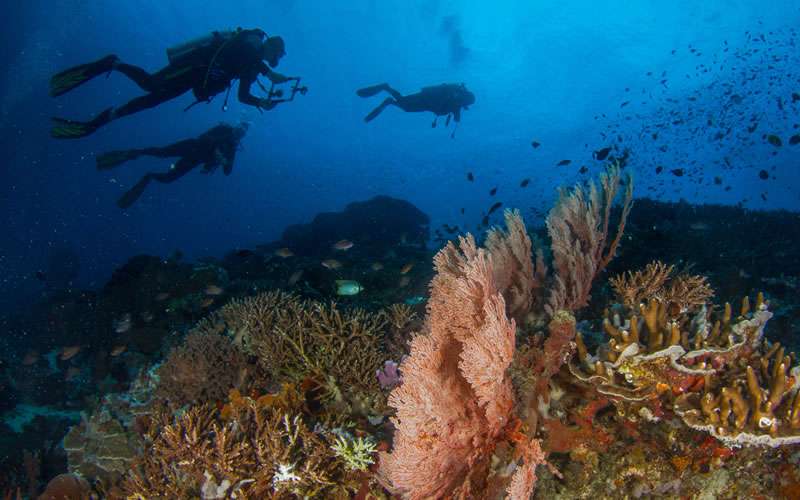Why is scuba diving on coral reefs significantly treacherous? According to the Global Coral Reef Monitoring Network, as of late 2000, an estimated 27% of the world’s coral reefs were severely damaged (GCRMN, 2000). Subsequently, the ‘Status of Coral Reefs of the World: 2020‘ report found that between 2009 and 2018 there was a progressive loss of about 14% of the coral from the Earth’s coral reefs.
Scuba diving, also known as recreational diving, is becoming an increasingly popular tourism activity. This has led to the term ‘dive tourism’ and is a significant contributor to some regional economies (Abidin & Mohamed, 2014). However, with its benefits comes a tradeoff; damage to coral reefs and marine biodiversity. The continual growth of the scuba diving industry causes coral reef damage, seen as one of the substantial anthropogenic impacts, and is of pressing concern. There are many dive shops carrying out unregulated and excessive diving activities. In addition to this, accidental contact with corals by new and inexperienced divers can cause recurring physical damage and heighten the pressure on coral communities (So et al., 2023). Understanding the ecological impact of scuba diving on coral reefs and spreading awareness amongst the diving community is crucial to developing more sustainable scuba diving practices.

Source: Unsplash
Understanding the impact of Scuba diving on coral reefs
In the pursuit of a thrivable future, THRIVE’s aim is to draw attention to the ways in which marine tourism affects coral reefs. There are several problematic practices that need addressing.
- Direct effects on coral reefs through accidental touching and boat activities such as collisions and anchor damage.
- Indirect effects through alteration of water quality in the form of nutrient enrichment, and the addition of pollutants such as toxic substances, wastewater and increased
turbidity.
Coral reefs are solid underwater structures that consist of calcium carbonate, secreted by corals. Most coral reefs are built from stony corals, which in turn consist of polyps that cluster in groups or colonies. The polyps belong to a group of animals known as Cnidaria, which also includes sea anemones (terrestrial flowering plants) and jellyfish. Unlike sea anemones, coral polyps secrete calcium carbonate, forming a hard exoskeleton that supports and
protects their bodies. Reefs grow best in tropical, shallow and clear waters. Coral reefs
provide a home for 25% of all marine species and provide shoreline protection. The annual global economic value of coral reefs is estimated to be between US$ 29.8-375 billion (Abidin & Mohamed, 2014).

Source: National Ocean Service
Regeneration of Coral Reefs
In addition to coral reefs being some of the most magnificent and biologically diverse habitats in the ocean, they are some of the oldest. They have grown over millions of years with some massive corals having growth rates of 0.3 to 2 centimeters per year. Branching corals have a faster (yet painfully slow) growth rate of up to 10 centimetres per year. Depending on their size, barrier reefs can take from 100,000 to 30,000,000 years to fully form (National Ocean Service, 2023).

Source: National Ocean Service
Main Causes of Damage to Coral Reefs as a Result of Scuba Diving
Divers swimming too close to the coral bed cause the sediment at the bottom to stir up. This exposes the coral polyps to increased sedimentation load, resulting in many effects which can be lethal. Some of these effects are asphyxia, abrasion, reduction in live coral cover, reduction in hard exoskeletons and changes in coral zonation (Abidin & Mohamed, 2014).
Further, divers may accidentally break corals by making contact with their fins, knees or hands. Some scientists believe that even a simple touch to the coral can trigger a syndrome called “Shut Down Reaction”. This reaction is caused when the layer of living tissue overlying the skeleton is abrased or the protective mucus layer is scraped off. Thus, making them prone to diseases. This damage takes decades to repair due to the coral’s slow regenerative capabilities.
Studies to determine the impact of scuba diving on coral reefs
To gain more insight into the harmful effects of scuba diving, there have been many scientific studies and monitoring programmes done at different diving locations. The impact divers have on coral reefs and fish communities have been widely documented in many areas around the world. A study performed in the Mediterranean shows that raising sediment is the most frequent effect divers produce, followed by contact with fragile organisms (such as corals and anemones) (Luna et al., 2009). The combination of these two effects is the main stressor agent for coral and fish.
Further, Danovaro et al. (2008) claim that the sunscreens divers use cause coral infections with a virus causing coral bleaching. Sunscreens induce a viral infection in coral which spreads and causes bleaching of hard corals. The chemicals from sunscreen even result in damaged DNA and deformed young.
In Hong Kong, the WWF carried out a citizen science monitoring programme. They invited 52 advanced divers to conduct direct underwater observations. Conversely, the main purpose of this study was to determine the intention-behaviour gap through a questionnaire, defined as the gap between the actual and perceived contact rates of divers. The results showed a total of 477 perceived contacts with marine biota, while actual contact recorded over twice as many (1,088) contacts. Another observation was that sand and rock were the main contact points for divers, with coral being lower. Hands and fins were found to be the dominant body part contact points.

Source: So et al., 2023
The questionnaire findings improved the framework of the dive-training programmes. In addition, to enhance divers’ awareness to minimise their influence on the marine environment.
actions to reduce the negative impact of scuba diving on coral reefs
The International Coral Reef Action Network (ICRAN) was launched in 1994 to address the rapid global decline of coral reefs. They are a global partnership endorsed by the United Nations Environment Programme (UNEP). The ICRAN Mesoamerican Reef Alliance (MAR) project, with the aim of confronting the decline of coral reef ecosystems, published standard requirements for recreational scuba diving. These guidelines include maintaining an awareness of fins, equipment and cameras and securing equipment to avoid contacting corals. Additionally, adjusting buoyancy aids in the avoidance of stirring up sediment. There were also guidelines established with regards to resisting touching reef-dwelling organisms, harassing marine life by swimming close to them, or chasing them (Philips, 2022).
Good practices that other parties that the diving community have undertaken
In addition to divers, the other interest groups in the industry include:
- Suppliers – dive operators and managers of marine protected areas.
- Purchasers – tour operators, hotels and cruise ships.
- Local communities.
- People with general interests – government agencies, non-government organisations, certifiers, academics and others.
The ICRAN MAR stipulates that marine recreation suppliers only employ dive leaders who are trained to the requisite level of competence by a recognised dive certification agency. Diver operators providing a guided dive should ensure the scuba diving group shall not exceed 8 divers. The dive leaders should also be able to communicate with at least 80% of the clients in their language. ICRAN also advised taking appropriate corrective actions when divers do not comply with the rules or local regulations for good environmental behaviour.
Furthermore, suppliers and purchasers are expected to support local marine protected areas and organisations working on coral reef conservation issues. They advise information and education for clients about the ecological, economic and cultural value of the area. We can expect that the standards will support local communities, providing monetary support to sustain conservation efforts in the area. It is advised that recreational scuba diving trips shall not be made to sites prohibited by national or local authorities. Further, suppliers shall voluntarily rotate dive sites to avoid their degradation and allow their recovery.
moving forward
Diving has grown in popularity due to diving lessons and certification and dive tours being easily available and more affordable. However, the degradation of coral reefs can lead to negative impacts on local tourism businesses, as coral reefs are the major attraction for Scuba divers.

Source: Greentumble
The sustainability of dive tourism requires several things. Firstly, the conservative efforts of coral communities. Secondly, the economic viability of all stakeholders, and cultural considerations of local communities. Thirdly, the provision of satisfying diving experiences. Implementation of all the guidelines has proven difficult. Individual standards exist due to the unique nature of each dive site and the varying local laws in each jurisdiction. Each dive site has to use its intuition and knowledge of best practices depending upon its characteristics. As a result, raising awareness and educating all marine recreation providers can be a vital step towards protecting marine resources.
Dive tourism brings economic benefits, improves the quality of life at each destination, fosters community pride, allows cultural exchange, reduces over-exploitation and promotes conservation. (Abidin and Mohamed, 2014
why Is it essential that we focus on Scuba diving on Coral reefs?
It is important we implement and maintain good practices while scuba diving for many reasons. Not only is scuba diving carried out recreationally; scientists and conservationists can better understand the biodiversity and intricate relationships within these ecosystems, helping to protect and preserve them for future generations.
Management measures to address the issue of coral reef damage include the introduction of programs designed to encourage environmentally responsible practices within the dive industry. Studies have shown that divers and dive operators with good dive practices exhibit significantly lower reef contact rates (Roche et al., 2016). The successful implementation of environmentally responsible diving programs can contribute to the management of human impacts on coral reefs.
achieving the United Nations Sustainable Development Goals (SDGs) and how they link to Scuba diving on Coral reefs
The United Nations has given humanity a “Code Red” warning against climate catastrophe. SDG 13 (Climate Action) states that if temperatures reach 1.5 degrees Celsius above pre-industrial levels, there will be a 70%-90% depletion of coral reefs. If temperatures reach the two degrees Celsius mark, coral reefs will completely die off.
Climate change is dramatically affecting coral reef communities by causing mass bleaching and biodiversity loss. They support 25% of all marine life, despite covering less than one per cent of the ocean floor (Coral Reef Alliance, 2023). It is important that we take action against global warming in line with the Paris Agreement target (IUCN, 2021). Science-based targets are the only chance to achieve these targets for the survival of coral reefs globally.
SDG 14 (Life Below Water) implies the importance of conserving marine resources and sustainable development. Our ocean, the planet’s largest ecosystem, is becoming increasingly endangered. Additionally, 90% of the world’s fisheries are employed in small-scale fisheries. The livelihoods of these local fishing communities are dependent on the health of the ocean.
A Thrivable Framework
THRIVE advocates for the conservation and protection of fragile ecosystems such as coral reefs. Our mission is to inspire the understanding that sustainable solutions not only avert catastrophe but also unlock the boundless potential for ecosystems to truly thrive and flourish.
As coral reefs are one of the main attractions for scuba divers, it is important we preserve its nature. Therefore, the dive industry, and the local community can continue to reap the benefits of dive tourism. Recommended diving behaviour and good scuba diving practices can ensure all living things can thrive in harmony.
THRIVE invests interest in issues fundamental to the integrity of our society. Learn more about how the health of oceans and biodiversity is vital for human well-being. Protecting our oceans and marine life can be the solution to our fight against climate change.
Join the Thrivability Matters Webinar Series to engage with expert speakers on topics focused around the Sustainability Development Goals such as ‘Life Below Water’ and ‘Life on Land’. Register for this exciting event here. Sign up for our newsletter to receive regular updates.